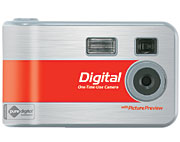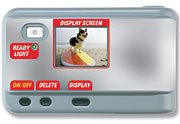| Classifieds: | | | | | | |
|
||||||||||||||||||||||||||||||||||||||||||||||||||||||||||||||||||||||||||||||||||||||||||||||||||||||||||||||||||||||||||||||||||||||||||||||||||||||||||||||||||||||||||||||

|
|||||||||||||||||||||||||||||||||||||||||||||||||||||||||||||||||||||||||||||
|
|||||||||||||||||||||||||||||||||||||||||||||||||||||||||||||||||||||||||||||
By Jefferson Graham, USA TODAY
SAN FRANCISCO — Jonathan Kaplan thinks digital cameras are too hard to use, so he decided to do something about it.
Kaplan, 36, is the CEO of Pure Digital Technologies, a scrappy start-up devoted to bringing digital photography to the masses. His solution: no wires, memory cards or having to connect the camera to the computer. Pure Digital makes the world's first truly digital one-time-use camera. It has been on the market for more than a year but is slated to go prime time Monday when CVS, the nation's largest drugstore chain, puts it on its shelves. The Disney World resorts and Longs Drugs will be selling it later this year as well.
Pure Digital is a $19.99 digital camera, with a color preview screen and the ability to delete pictures. After you bring it in for processing, you get a free picture CD along with your prints. Industry giant Kodak is heavily advertising its Plus Digital one-time-use camera. But that is a film camera with no preview screen. The "digital" component is a free picture CD bundled in. That Kodak is promoting its camera during the Olympics doesn't worry Kaplan. "They created awareness for the category," Kaplan says. "What would concern me is if Kodak had done a true digital one-time-use camera. Can you see the picture after you've taken it on their camera? No. Can you delete images? No. They've made it very easy to compete." The digital revolution Digital cameras have transformed photography. Millions of consumers have replaced their film cameras with digital models. Shutterbugs also have flocked to cell phones with built-in cameras. The trend has decimated film sales. One bright spot for traditional camera makers: those small, one-time-use cameras that sell for $4 to $10, an area Kodak and rival Fuji dominate. But market tracker IDC projects that sales of those click-and-toss cameras will peak this year at 460 million units — to be eclipsed by camera phones. Kaplan says his company can capitalize on the shift. The secret of his business model is not just persuading retailers to stock his product — but an image processor unit as well. It gets hooked up to the store's minilab to transfer pictures from the camera. Unlike traditional digital cameras, you can't connect the Pure Digital camera to a home PC to transfer images. And retailers like that. It brings customers into the store, Kaplan says. The image processor also will talk to camera phones in the future. When shoppers visit the stores, a Pure Digital software application can be beamed into phones that lets users send pictures directly to the store for prints. Later this year, the company says it will introduce a video camera with 20 minutes of TV-quality footage that will be processed in the store onto a DVD. In-store prints Pure Digital's San Francisco offices are typical pod-style workstations, with computers and posters everywhere. Large images of waterfalls, mountains and beaches adorn the walls — all snapped by a Pure Digital camera, which has the equivalent of a 2-megapixel sensor. A megapixel is a measurement of a camera's resolution. Pure Digital grew out of the ashes of Kaplan's now-defunct Family Wonder parental advice Web site after it was sold to video game manufacturer Sega. Kaplan, the founder of Family Wonder, invested $200,000 with a co-worker, software developer Ariel Braunstein. They've since raised additional funds. One investor, Bruce Dunlevie of Silicon Valley's Benchmark Capital, says he was sold on Kaplan's vision that digital fans would eventually want to get store-made prints again. According to the Photo Marketing Association International, only 25% of digital camera owners get prints from labs, a number expected to increase in the coming years. "Jon's instincts about what consumers want and how they will behave were right on," says Dunlevie, who was one of the first investors in PDA pioneer Palm and online photofinisher Ofoto. Pure Digital first exhibited at a photo trade show in 2002. A few months later the company was testing a camera at Wisconsin Walgreens stores and some Ritz Camera Centers. While the camera was cheap — $11 — it lacked a preview screen. Sales weren't as strong as expected. Engineers went to work on a second-generation unit, which began shipping this summer to Ritz stores for $19.95. Now it's headed to CVS. Michelle Slaughter, an analyst at research firm InfoTrends, calls the CVS move "the real test, to see how the mass market responds." Kaplan predicts he'll have sold 500,000 cameras by the end of the year and that his private firm will be profitable by next year. IDC analyst Chris Chute thinks Pure Digital will have a tough time going beyond being a niche player. "They're appealing to a market that thinks digital is too expensive," he says. "These consumers won't spend more money for the Pure Digital camera when they still have to pay for prints, too." Bad shot? Delete it Kaplan argues that his delete button — even on the $9.95 model without a preview screen — gives him a huge advantage over other models. "People will pay more to know they're not going to waste pictures," he says. "Even if you can't see the final image, people know that when a bus drives into the frame or a kid closes his eyes after you snapped the shutter that it's not worth saving." Pure Digital's cameras are produced in China. After the consumer uses them, they are shipped by the retailer to a recycling facility in Chicago, where they're refurbished and repackaged. Kaplan won't say how many times the cameras are recycled, but the industry average is five to eight times. Amazingly, in an industry known for instant knockoffs, no firm has yet tried to follow Pure Digital with a me-too one-time-use digital. "If they have, they haven't called me yet," says David Ritz, CEO of Ritz Camera Centers, the nation's largest photo chain. "There are a lot of challenges to setting up such a complex system — a big infrastructure of servers and dealers," Slaughter says. "If Kodak wanted to do something like this, they have the resources. Most don't." |
|||||||||||||||||||||||||||||||||||||||||||||||||||||||||||||||||||||||||||||


